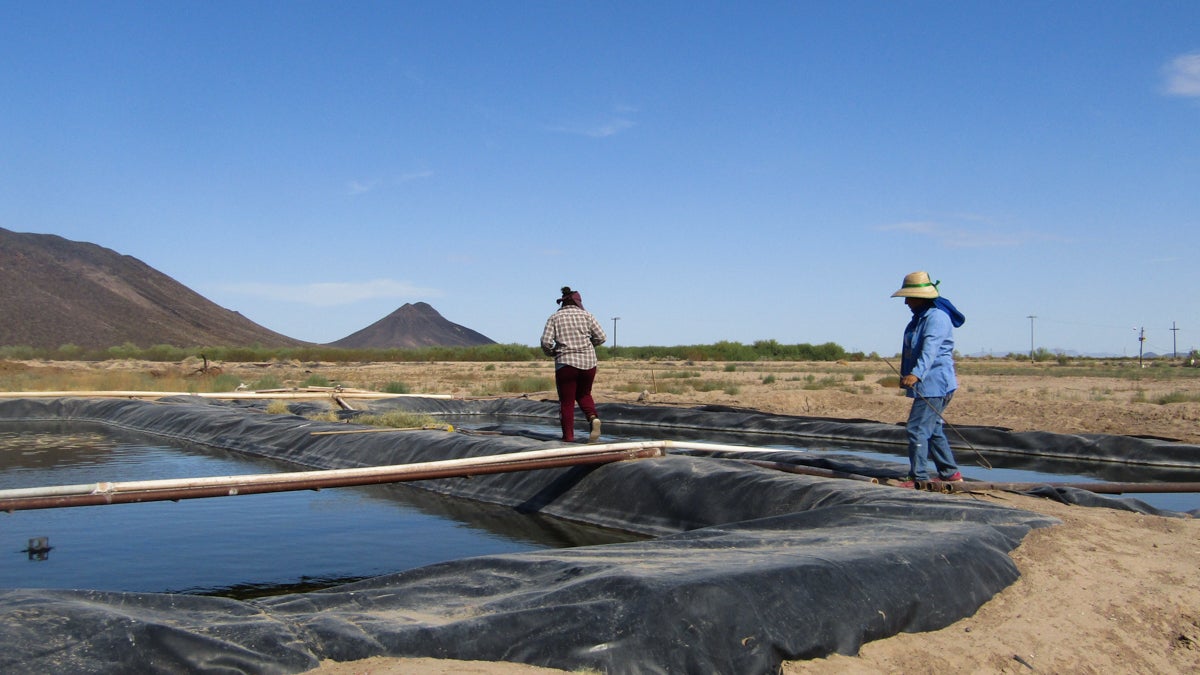The surprising perks of farming fish in the desert
Listen
In the dry
Fish farming is most lucrative in places where there are fish; coastal states like California or Louisiana. But in the middle of rural Arizona, where water isn’t as easy to come by, one farmer has decided to venture into a sustainable way of fish farming that actually reuses the water the fish live in.
A desert fish farm
Desert Springs Tilapia is a farm 100 miles southwest of Phoenix in the middle of the Sonoran desert. I got there early on a weekday in late July and my dashboard thermometer read 100 degrees, at 9 a.m. In the sun, it’s even hotter, which is why when I asked farm owner Tark Rush for a tour of the grounds, he insisted on meeting me in the morning. It feels like a busy day as he rolled up a little late in his pickup. In the distance, we saw workers hauling a crane on a truck.
“I think they might be harvesting up there,” Rush said. “We’ll jump in my car and we’ll go.”
He drove me around his 700-acre farm, and after five mins on dusty roads, we arrived at what I came to see – the fish tanks.
They’re plastic lined, some sunk into the ground like oversized ponds. Great Pyrenees dogs, their white fur dusty from a day of herding goats lumbered around the tanks, which just a few hours ago held thousands and thousands of shiny, wriggling fish.
“This was striped bass in here, and now they’re harvesting them to take up and pack,” he said.
This farm is basically the sustainable marriage of fish farming and plant growing.
Rush started farming fish 14 years ago after studying aquaculture at the University of Arizona.
“So I just kind of learned slowly and steadily and I decided, hey, I can make a little money doing this.”
And what makes Rush’s desert farm different, besides the fish and the goats, is its proximity to two groundwater wells. One is for cool water and one produces warm water. That setup comes out of the geology of the area, where the black boulders dotting the landscape hint at what 400 million years ago was a massive volcano, making it easier to grow a warm water fish like tilapia.
“This area’s called Agua Caliente which is hot water.” Rush said. “Our hottest well is 107 degrees, hotter than a jacuzzi, and our cold well is 74 degrees.”
He utilizes those wells to grow two types of fish. And the most unique part of the farm? Rush takes the fish water and then uses it to irrigate and fertilize his crops.
“What I’m trying to do is everywhere we’re pumping water we’re going to put fish in front of it,” Rush explained. “That will save on fertilizer and save on half of the pumping costs.”
Basically, the water the fish live and poop in will be recycled onto his other crop bermuda grass. And the fish water has nutrients which fertilizes the grass. And the grass feeds his goats, and the goats are sold for meat, and the cycle goes on.
And that’s how he’s able to make double the product using the same amount of water he would for just growing acres and acres of crops.
The future of sustainable fish farming
Kevin Fitzsimmons teaches and studies environmental science at the University of Arizona, and Tark Rush was one of his students.
“We’re really cognizant of the fact that we have limited water resources in the desert,” Fitzsimmons said.
Fitzsimmons is an expert on aquaculture. He says over 50 percent of fish are farmed now.
In fact, Fitzsimmons says fishing in the wild oceans has an expiration date.
“It was a romantic thing that in actuality was always more dangerous, harder work and less money,” Fitzsimmons said. “It’s just a really hard occupation that’s going away very quickly.”
So where are we going to get our fish in the future? For some, like retired high school biology teacher John Healy, it’s right in their backyard.
“We grew over 300 heads of lettuce, spinach, chard, kales, last spring,” Healy said. “And another 300 last fall.”
Healy lives in a suburb of Phoenix and started small aquaponic setups in the classroom. Aquaponics is where the farmer grows veggies directly from water fish live in, without any soil. Healy kept it going at home because he believes in sustainable farming and wants to spread the word.
“It’s a lab site, like a laboratory for people who want to get into aquaponics in their backyard,” he said.
Above-ground tanks hold tilapia in Healy’s large backyard, and are covered in green vegetables.
Healy says each year, he’s able to expand his setup because more gardeners come to buy home aquaponics kits from him.
“I see more dirt farmers moving to aquaponics,” he said. “It’s like I’m almost like doing missionary work trying to convert these people.”
Back in the middle of the desert, Tark Rush is still trying to do more to convert his dirt farm into something more sustainable.
And at the end of our tour, Rush cooks me goat pozole, made with his own goats, and it’s good – spicy, and gamey.
I ask him about his desert roots while he turns the stove on.
“I’m a farmer at heart. I grew up farming. I grew up here, my family used to own a grape farm, my family did.”
Rush is still looking for innovative ways to make his farming more sustainable. But what it all comes down to, as for any businessman, is the money.
“There’s a certain amount of people that would like this system and like the way it’s sustainable but in the long run, it’s based on price and the quality of your product.”
And if everyone could try this goat pozole, it wouldn’t take much convincing that Rush has got this sustainable farming in the desert thing figured out.
WHYY is your source for fact-based, in-depth journalism and information. As a nonprofit organization, we rely on financial support from readers like you. Please give today.



